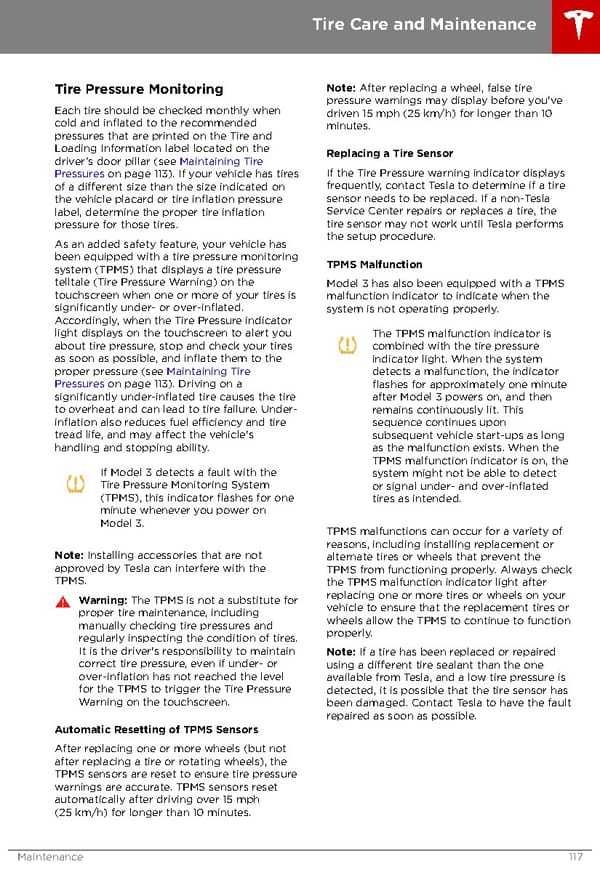Tire Care and Maintenance Tire Pressure Monitoring Note: After replacing a wheel, false tire pressure warnings may display before you've Each tire should be checked monthly when driven 15 mph (25 km/h) for longer than 10 cold and inflated to the recommended minutes. pressures that are printed on the Tire and Loading Information label located on the Replacing a Tire Sensor driver†s door pillar (see Maintaining Tire Pressures on page 113). If your vehicle has tires If the Tire Pressure warning indicator displays of a different size than the size indicated on frequently, contact Tesla to determine if a tire the vehicle placard or tire inflation pressure sensor needs to be replaced. If a non-Tesla label, determine the proper tire inflation Service Center repairs or replaces a tire, the pressure for those tires. tire sensor may not work until Tesla performs As an added safety feature, your vehicle has the setup procedure. been equipped with a tire pressure monitoring TPMS Malfunction system (TPMS) that displays a tire pressure telltale (Tire Pressure Warning) on the Model 3 has also been equipped with a TPMS touchscreen when one or more of your tires is malfunction indicator to indicate when the significantly under- or over-inflated. system is not operating properly. Accordingly, when the Tire Pressure indicator light displays on the touchscreen to alert you The TPMS malfunction indicator is about tire pressure, stop and check your tires combined with the tire pressure as soon as possible, and inflate them to the indicator light. When the system proper pressure (see Maintaining Tire detects a malfunction, the indicator Pressures on page 113). Driving on a flashes for approximately one minute significantly under-inflated tire causes the tire after Model 3 powers on, and then to overheat and can lead to tire failure. Under- remains continuously lit. This inflation also reduces fuel efficiency and tire sequence continues upon tread life, and may affect the vehicle's subsequent vehicle start-ups as long handling and stopping ability. as the malfunction exists. When the TPMS malfunction indicator is on, the If Model 3 detects a fault with the system might not be able to detect Tire Pressure Monitoring System or signal under- and over-inflated (TPMS), this indicator flashes for one tires as intended. minute whenever you power on Model 3. TPMS malfunctions can occur for a variety of reasons, including installing replacement or Note: Installing accessories that are not alternate tires or wheels that prevent the approved by Tesla can interfere with the TPMS from functioning properly. Always check TPMS. the TPMS malfunction indicator light after Warning: The TPMS is not a substitute for replacing one or more tires or wheels on your proper tire maintenance, including vehicle to ensure that the replacement tires or manually checking tire pressures and wheels allow the TPMS to continue to function regularly inspecting the condition of tires. properly. It is the driver's responsibility to maintain Note: If a tire has been replaced or repaired correct tire pressure, even if under- or using a different tire sealant than the one over-inflation has not reached the level available from Tesla, and a low tire pressure is for the TPMS to trigger the Tire Pressure detected, it is possible that the tire sensor has Warning on the touchscreen. been damaged. Contact Tesla to have the fault repaired as soon as possible. Automatic Resetting of TPMS Sensors After replacing one or more wheels (but not after replacing a tire or rotating wheels), the TPMS sensors are reset to ensure tire pressure warnings are accurate. TPMS sensors reset automatically after driving over 15 mph (25 km/h) for longer than 10 minutes. Maintenance 117
 Tesla Model 3 | Owner's Manual Page 117 Page 119
Tesla Model 3 | Owner's Manual Page 117 Page 119